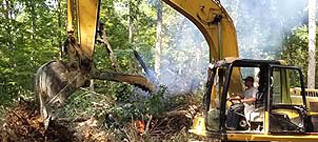Environmental Commentary by Tom Horton
Life’s still good, but death’s just become more interesting.
I always figured on cremation—modest expense, no concrete, bronze and embalming chemicals in the earth; friends and family would enjoy scattering the ashes in cool places I’d enjoy designating.
But Doug Carroll and his wife, Deirdre Smith, have reset my expectations and broadened my endgame with a recent autumn ramble through the wooded hills and meadows of the farm they’ve bought on Resh Mill Road in northern Baltimore county.
They’ve got me thinking beyond the mere low environmental impact of cremation —which does generate some greenhouse gas and mercury—and about how my expiration can give back to the land, can atone somewhat for living well and unsustainably like most of my fellow Americans.
The deal is something called conservation burial, and Doug and Deirdre are moving through state and county approvals to qualify 66 acres as a burial ground. They’re calling the farm Resh Mill Preserve.
It’s a significant step beyond “green” or low-impact burials, which have literally been around forever. Green burial is essentially no embalming, plain shroud or simple pine box. Rural cemeteries in some places still permit it, and Jews and Muslims and Eastern Orthodox Christians mostly practice it.
Conservation burial takes your money—about $3,000, Doug is thinking, competitive with cremation—and puts it back into restoring the site where you’re planted with native plantings, and into protecting the surrounding landscape forever. They’ve already put a permanent conservation easement on the Resh Mill farm, and hope to spur similar protection for the whole drainage, which flows through Graves Run into Prettyboy Reservoir.
The possibilities for this are intriguing. Purchase price of the farm was about two-thirds of a million bucks. Resh Mill could, Doug says, be approved for 3,000 grave sites, which would generate about $9 million over its life as a conservation burial ground.
With about 45,000 deaths annually in Maryland, you begin to see the potential for conserving natural landscapes. Nationwide, it’s estimated Americans will spend half a trillion dollars on funerals annually as Baby Boomers move to their final reward. What if even a 10th of that translated into conservation burials, into rewarding nature?
The concept for many takes some getting used to. Will it harm water quality as bodies rapidly decompose? Will wild animals dig you up? (No and no.)
And nothing much will mark your final resting place at Resh Mill, other than GPS coordinates and metal discs underground required by Maryland. The whole idea is that the mixed hardwood forests and grassy fields will look, filled with bodies, much like they do now—even better as the owners are already clearing out invasive species and planting native ones.
Trails and a small parking and picnic area, for visitors will be maintained. One might choose to mark a grave with a name etched into one of the flat stones that already dot the site; but no one will mow around it. Nature will simply take its course. Indeed, tree planting at a gravesite will be welcome, but likely the only ones who will benefit are the abundant white-tailed deer, Doug says.
Conservation burial is hardly common, but at least one such place, Ramsey Creek Preserve in rural Westminster, S.C., has been going for almost 20 years. “We’re quite busy,” said its founder, Billy Campbell, a medical doctor like Doug Carroll and a mentor to Resh Mill.
Campbell and his wife, Kimberly, have developed standards and a certifying organization for green and conservation burials, and have helped start several similar places around the country.
A particular success, he said, is the conservation burial ground operated by a monastery near Atlanta, which is using the profit from 70 acres to keep another 1,000 acres in its natural state—and that acreage is in turn part of a much larger greenway project along Georgia waterways. Other conservation burial sites include ones in Ohio, Ithaca, N.Y., Florida near the state university, and one near Chicago.
The greatest potential, Campbell said, lies in establishing conservation burial near major cities. “You aren’t looking for pristine lands, but lands that need to be restored to their natural state.”
He has explored linking large conservation organizations, like Audubon and The Nature Conservancy, to conservation burial projects. He sees it “as a powerful tool to change the way people look at landscapes.”
I like the humility and the connectedness of joining with the bodies and cash of others to protect beautiful panoramas, to evolve as they will, my grave nowhere, yet everywhere in the landscape.
Try as we might, in life it’s hard for modern humans to live peaceably with the rest of nature. But in death, the possibilities seem bright.
Tom Horton covered the Bay for 33 years for the Baltimore Sun and is author of six books about the Chesapeake. Distributed by Bay Journal News Service


